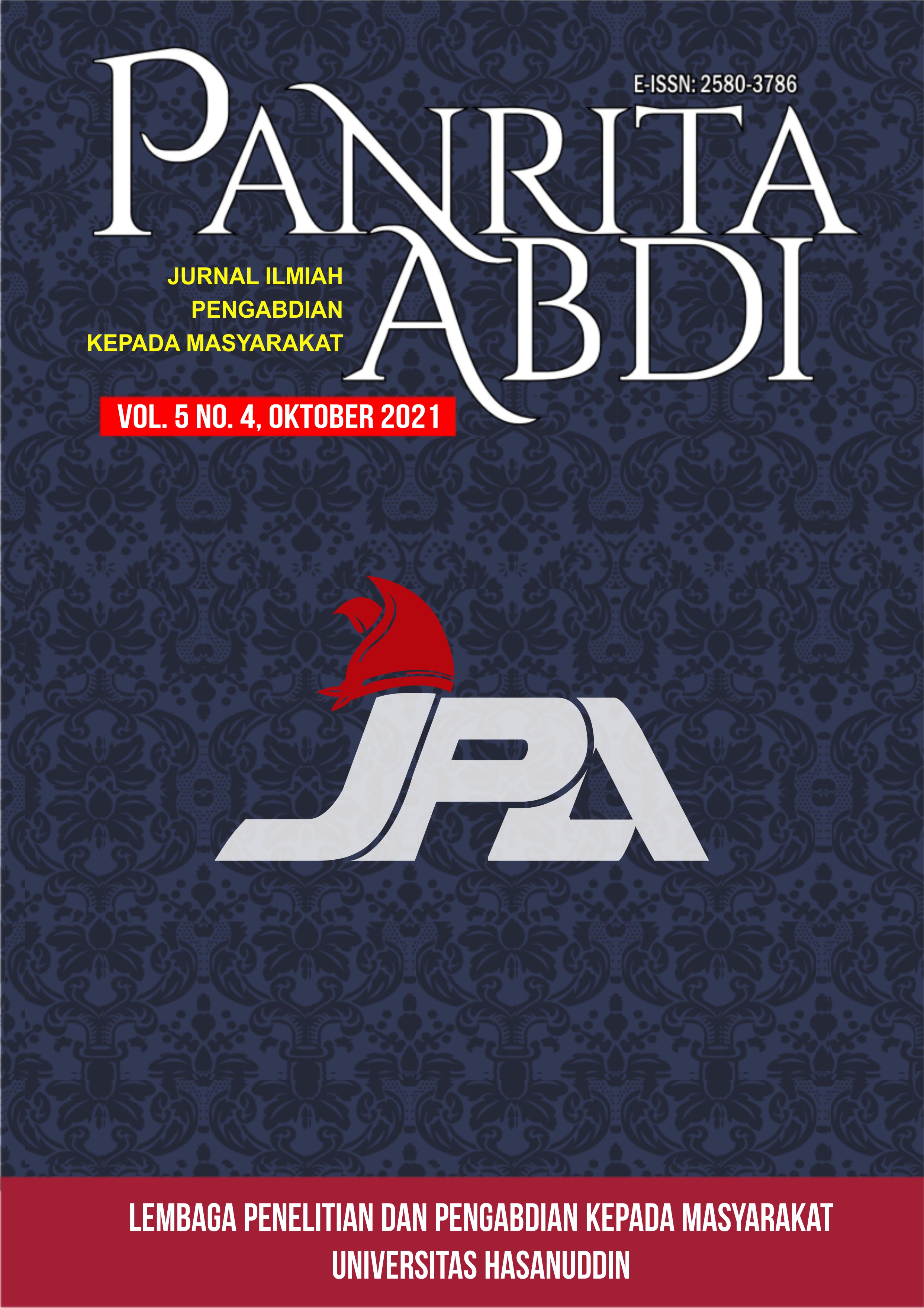PEMANFAATAN PEMBANGKIT LISTRIK HYBRID DALAM MENDUKUNG ELEKTRIFIKASI DI KAWASAN JAVAN LANGUR CENTRE KOTA BATU JAWA TIMUR
DOI:
https://doi.org/10.20956/pa.v5i4.11286Keywords:
Hybrid power plant, : picohydro power plant, solar power plant, javan langur centreAbstract
Javan Langur Center (JLC) is a Javan Langur rehabilitation center located approximately 10 km from the center of Batu city, East Java. To support activities at this rehabilitation center, electrical energy is needed, especially to meet the needs of lighting facilities and the operation of a primate baby incubator machine. To date, no electricity distribution network from the State Electricity Company (PLN) has entered the area. To meet these electricity needs, the electricity supply is obtained from a gen-set owned by residents which is approximately 2 km from the JLC. This Community Service Program was carried out between February and August 2020 with activities in the form of the construction of a hybrid power plant to meet the electricity needs of the JLC. The hybrid power plant that is installed is a combination of pico-hydro power plant technology (PLTPH) and solar power plant (PLTS). During the implementation of the program, there were two activity partners who played an active role, namely The Aspinall Foundation Indonesia Program (JLC manager) and the Javan Lutung Conservation Community, with a total of about 10 personnel. The result of this community service program is the installation and operation of a hybrid power generation system, which consists of a 300-watt pico-hydro power plant and a 200-watt peak solar power plant. With this hybrid power plant, the electricity needs in the JLC area for lighting and operating the Lutung baby incubator machine, with a total power of 180 watts, can be met. In addition, to maintain the sustainability of the operation and maintenance of the hybrid power plant, a transfer of knowledge and skills has been carried out to partners, namely The Aspinal Foundation Indonesia Program and the Javan Lutung Conservation Community. --- Javan Langur Center (JLC) adalah pusat rehabilitasi Lutung Jawa yang terletak lebih kurang 10 km dari pusat kota Batu, Jawa Timur. Untuk menunjang kegiatan di pusat rehabilitasi ini, energi listrik sangat dibutuhkan, terutama untuk memenuhi kebutuhan fasilitas penerangan dan pengoperasian mesin inkubator bayi primata. Sampai saat ini, belum ada jaringan distribusi listrik dari Perusahaan Listrik Negara (PLN) yang masuk di kawasan ini. Untuk memenuhi kebutuhan listrik tersebut, pasokan energi listrik didapatkan dari gen-set milik warga yang jaraknya kurang lebih 2 km dari JLC. Program Pengabdian Kepada Masyarakat ini dilaksanakan antara bulan Pebruari sampai bulan Agustus 2020 dengan kegiatan berupa pembangunan pembangkit listrik hybrid untuk memenuhi kebutuhan listrik di JLC. Pembangkit listrik hybrid yang dipasang merupakan penggabungan teknologi pembangkit listrik tenaga pikohidro (PLTPH) dan pembangkit listrik tenaga surya (PLTS). Selama pelaksanaan program, ada dua mitra kegiatan yang berperan aktif, yakni The Aspinall Foundation Indonesia Program (pengelola JLC) dan Komunitas Konservasi Lutung Jawa, dengan total personel sekitar 10 orang. Hasil program pengabdian kepada masayarakat ini berupa pemasangan dan pengoperasian sistem pembangkit tenaga listrik hybrid, yang terdiri atas pembangkit listrik tenaga piko hidro berkapasitas 300 watt dan pembangkit listrik tenaga surya berkapasitas 200 watt peak. Dengan adanya pembangkit listrik hybrid ini, maka kebutuhan listrik di area JLC untuk penerangan dan pengoperasian mesin inkubator bayi Lutung, dengan total daya 180 watt dapat terpenuhi. Selain itu, untuk menjaga keberlangsungan pengoperasian dan pemeliharaan pembangkit tenaga listrik hybrid tersebut, telah dilakukan transfer pengetahuan dan keterampilan kepada pihak mitra kerja, yakni The Aspinal Foundation Indonesi Program dan Komunitas Konservasi Lutung Jawa.
References
Referensi
Ramadhan, A.I., Diniardi, E., & Mukti, S. H. (2016). Analisis Desain Sistem Pembangkit Listrik Tenaga Surya Kapasitas 50 WP. Teknik, 37(2), 59-63.
Dedisukma, Sunanda, W., & Gusa, R. F. (2015). Pemodelan Sistem Pembangkit Listrik Hybrid Diesel Generator Dan Photovoltaic Array Menggunakan Perangkat Lunak Homer (Studi Kasus di Pulau Semujur Kabupaten Bangka Tengah). Jurnal Ecotipe, 2(2), 10-17.
Yadav, G., & Chauhan, A.K. (2014). Design and Development Of Pico Micro Hydro System By Using House Hold Water Supply. International Journal of Research in Engineering and Technology, 03(10), 114-119.
Hankins, M. (2010). Stand- Alone Solar Electric Systems. Earthscan, New York.
Hidayat, M. N., Rahmat, A. N., & Ronilaya, F. (2020). Feasibility Analysis of a Renewable Autonomous Power Supply System at a Coastal Area in Indonesia. International Journal of Energy Economics and Policy, 10(3), 175-181.
Dwiyaniti, M., Riandini, & Supriyono, E. (2020). Pemanfaatan Solar Sel dan Budidaya Perikanan Sebagai Upaya Menuju Kemandirian Finansial
di Sekolah KAMI. Jurnal Panrita Abdi, 4(2), 146-154.
Syahputra, R., & Soesanti, I. (2020). Planning of Hybrid Micro-Hydro and Solar Photovoltaic Systems for Rural Areas of Central Java, Indonesia. Journal of Electrical and Computer Engineering, Volume 2020, Hindawi, 1-16.
Sankar, A., Shubra, S., & Mishra, S. (2013). A Multi- Input Single ¬Control (MISC) Battery Charger for DC Nanogrids. 2013 IEEE ECCE Asia Downunder.
Nakhoda, Y. I., Sulistiawati, I. B., & Soetedjo, A. (2018). Penerapan Pembangkit Listrik Tenaga Pikohidro Menggunakan Komponen Bekas Dengan Pemanfaatan Potensi Energi Terbarukan Di Desa Gelang Kecamatan Sumberbaru Kabupaten Jember. Jurnal Aplikasi Dan Inovasi Ipteks. Soliditas, 1(2), 99-109.
Downloads
Published
How to Cite
Issue
Section
License
Copyright (c) 2021 Mohammad Noor Hidayat, Ferdian Ronilaya, Irwan Heryanto/Eryk, Sapto Wibowo, Lukman Hakim

This work is licensed under a Creative Commons Attribution-NonCommercial-NoDerivatives 4.0 International License.











